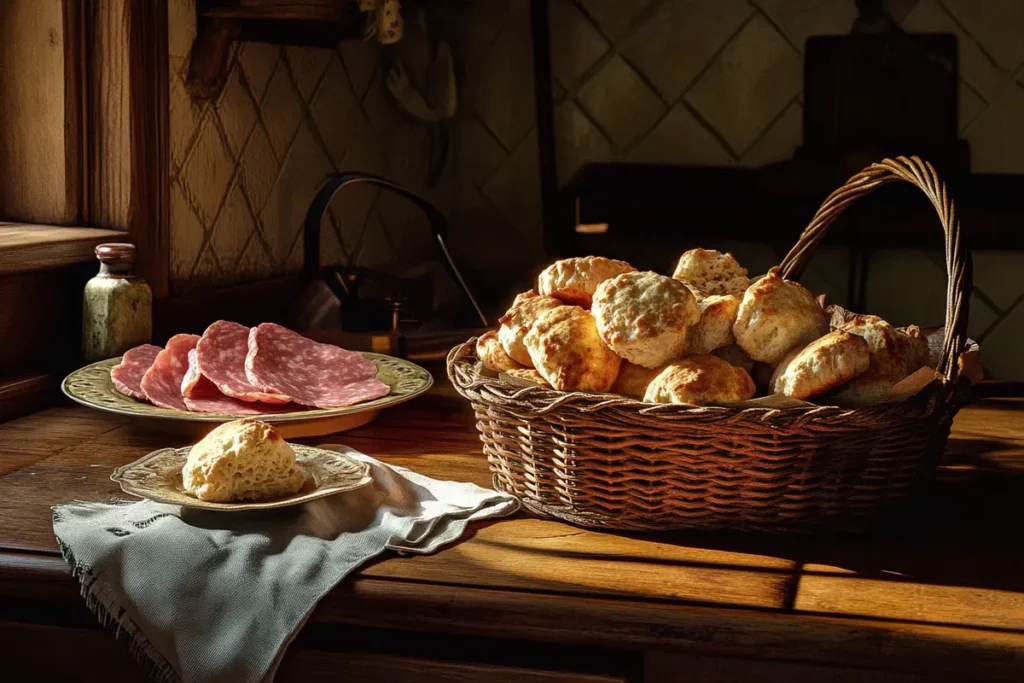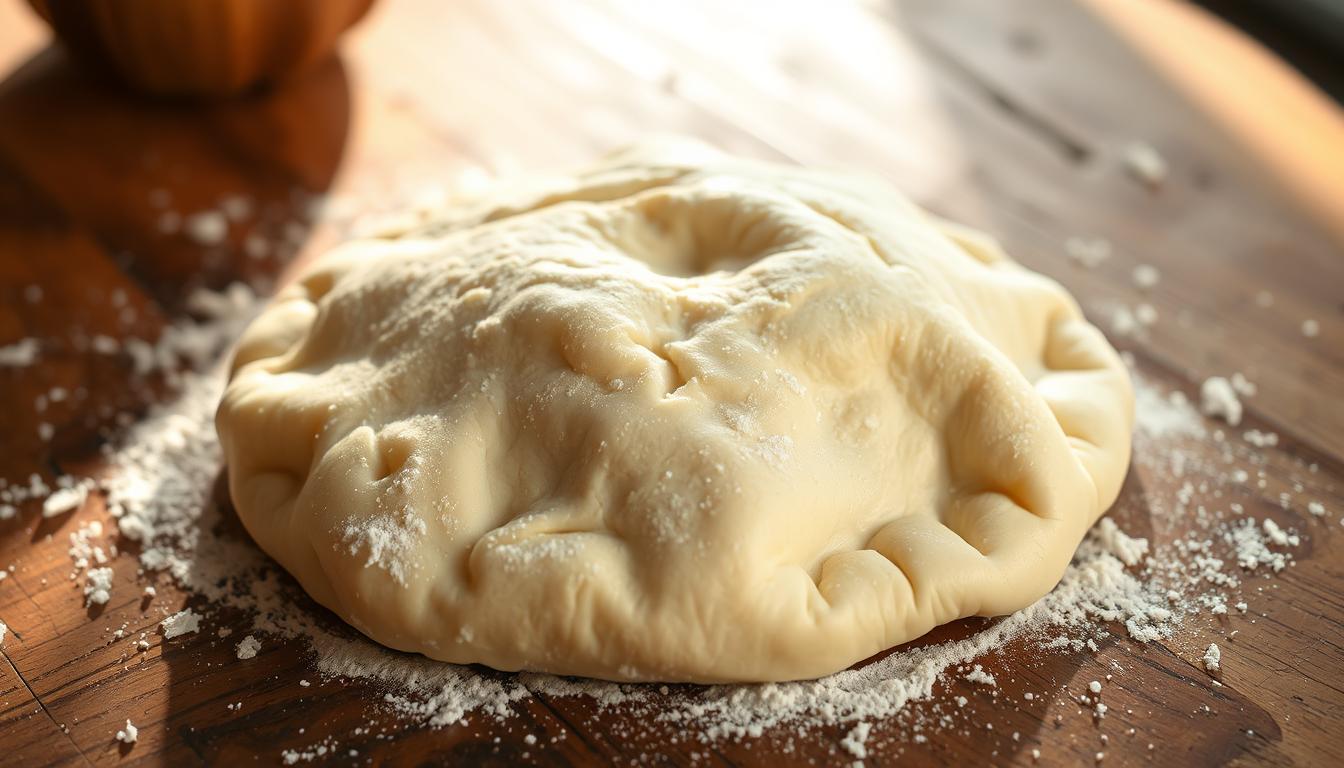Are you craving something warm, satisfying, and full of character? If so, a ham biscuit recipe might be just what you need. These tender biscuits, layered with savory ham, can fit seamlessly into breakfasts, lunches, potlucks, or late-night snacks. Perhaps you have tried standard biscuits before but have not explored the possibility of adding ham directly into the mix or pairing slices of ham with a homemade biscuit dough. In this conversational guide, we will break down everything you should know, from biscuit basics to various ways you can customize your dough. By the end of this read, you will feel well-prepared to roll up your sleeves and whip up a batch of ham biscuits that will impress friends, family, and, most importantly, your own taste buds.
1. Tracing the Roots of a Ham Biscuit Recipe

When you think of a ham biscuit recipe, you might instantly imagine quaint Southern kitchens where cooks have mastered the art of baking light, flaky biscuits. Indeed, ham biscuits boast a longstanding history in American cuisine, particularly in Southern states like Virginia, Tennessee, and North Carolina. Over generations, families have passed down cherished recipes, each with its own twist—perhaps a unique type of ham, a secret leavening ratio, or a finishing sauce.
It is easy to see why these traditions endured. Ham biscuits are portable, crowd-pleasing, and adaptable to different dietary needs. Many folks remember them fondly from holiday gatherings, church events, or even school fairs. The sight of freshly baked biscuits paired with salty ham is instantly comforting. While old-fashioned methods still hold up, modern kitchens have embraced new flavors, flours, and add-ins. Nevertheless, the essence of a ham biscuit recipe remains the same: a tender crumb, a hint of butter, and the delightful taste of smoked or cured ham.
2. The Essential Appeal of a Ham Biscuit Recipe
Before diving into detailed steps and ingredient lists, let us explore why people find a ham biscuit recipe so enticing. What sets these biscuits apart from other variations?
- Simplicity: A few staple items—flour, butter, leaveners, milk or buttermilk—create a reliable biscuit foundation. Adding ham only requires a slight adjustment.
- Versatility: You can make miniature ham biscuits as appetizers or full-sized versions for a hearty meal. They match with eggs, gravy, cheese, or even sweet elements like honey and jam.
- Universal Appeal: Whether you prefer a mild ham for a subtle flavor or a robust country ham with a salty punch, the biscuit dough absorbs and balances that savoriness. People who typically shy away from strongly flavored meats often enjoy ham biscuits because the biscuit softens the intensity.
Furthermore, biscuits are famously easy to store, freeze, and reheat. This advantage means you can prepare large quantities in advance for social events or lazy weekend brunches. A well-chosen ham can turn a plain biscuit into an unforgettable treat that feels both comforting and a little special.
3. Understanding the Science of Biscuits
Before jumping into the specifics of a ham biscuit recipe, it helps to grasp the biscuit-making essentials. Biscuits rely on creating layers of dough that trap air and steam during baking. When butter or another fat melts in the oven, it leaves behind pockets that translate to flakiness. Proper biscuit texture depends on a few important rules of Ham biscuit recipe classic taste modern twist ingredients:
- Cold Ingredients: Keeping butter, milk, and even flour cold preserves solid fat pockets. As the biscuit bakes, these fat chunks melt and help form the airy layers.
- Minimal Handling: Overworking the dough can activate too much gluten. That toughness suits bread loaves but not biscuits, which should be tender.
- Correct Leavening: Typically, baking powder (and sometimes baking soda if an acid like buttermilk is involved) ensures the dough rises. Outdated leaveners yield dense results.
- Quick Baking: Biscuits need a jolt of high heat. Temperatures around 425°F to 450°F encourage rapid rise, forming those characteristic layers.
When ham enters the picture, you add not only flavor but also a bit of moisture or saltiness. If the ham is extremely salty, you may slightly reduce the salt in your dough. If the ham is very moist, you may add a touch more flour. Either way, the structural foundation remains consistent: keep your ingredients cold, handle the dough briefly, and bake at high heat.
4. Picking the Right Ham for Your Ham Biscuit Recipe
Choosing ham for your ham biscuit recipe might be a more nuanced decision than you think. Various ham styles can elevate or shift the overall flavor profile of your biscuits:
- Country Ham: Often salt-cured and robustly flavored. The dryness complements the moist biscuit dough well, but be careful about overall salt content.
- City Ham (Spiral-Cut Ham): Less salty and more commonly found in supermarkets. It is often pre-sliced and can add a gentle sweetness.
- Smoked Ham: Carries a distinct smoky undertone. This type is especially nice for individuals who love a bit of barbecue-like essence.
- Leftover Holiday Ham: Great for resourceful cooks who dislike wasting leftovers. You can shred or slice it for layering into your biscuits.
Regardless of your choice, ensure you have ham that is not overly watery. If it is, you might want to pat it dry with a paper towel before using. Consistency in ham pieces (chunks, shreds, or thin slices) also helps maintain uniform distribution in each biscuit. Large lumps can cause uneven baking or hamper the biscuit’s ability to puff.
5. Gathering Must-Have Ingredients
A basic ham biscuit recipe shares similarities with other biscuit recipes, plus the addition of ham. Still, the right combination and quality of ingredients can make a huge difference:
- All-Purpose Flour: The typical base for biscuits. Some people prefer a blend of all-purpose and cake flour for extra tenderness.
- Leavening Agents: Fresh baking powder and possibly a touch of baking soda.
- Salt: Adjust based on the saltiness of your ham.
- Butter (or Shortening): Cold and cut into small cubes. Butter provides a rich taste, while shortening can yield a slightly flakier texture. A 50-50 blend is another option.
- Buttermilk or Milk: The liquid that binds the dough. Buttermilk offers tang and tenderness.
- Ham: Either diced small, cut into strips, or placed as whole slices.
- Optional Sweeteners: A hint of sugar or honey, if you want a sweeter biscuit.
- Herbs or Cheese (Optional): Rosemary, thyme, cheddar, or other add-ins can boost the flavor.
Some advanced bakers weigh their flour instead of relying on measuring cups to ensure precision. This can help avoid overly dense or sticky dough due to inaccurate measurements. Although this extra step might feel meticulous, it pays off by guaranteeing consistent results time after time.
6. Detailed Ham Biscuit Recipe Step-by-Step

Below is a streamlined guide on assembling a ham biscuit recipe. The process remains straightforward even if you are relatively new to baking:
- Preheat Your Oven
- Warm it to around 425°F (218°C).
- Line a baking sheet with parchment for easy cleanup.
- Combine Dry Ingredients
- In a large bowl, whisk 2 cups of all-purpose flour, 1 tablespoon baking powder, and 1 teaspoon salt.
- Adjust salt down if using very salty ham.
- Cut in Butter
- Take 5 tablespoons of cold butter, diced into cubes.
- Use a pastry blender or fork to blend until the mixture resembles coarse crumbs.
- Keeping some small pea-sized butter lumps is fine.
- Add Liquid
- Pour in 3/4 cup of cold buttermilk (or milk).
- Stir gently until a dough forms.
- If it seems dry, add a tablespoon more buttermilk. If overly wet, sprinkle in a bit more flour.
- Fold in Ham
- If using diced ham, fold it into the dough.
- If you prefer layering slices, you can incorporate them later when shaping or cutting.
- Shape the Dough
- Transfer dough to a floured surface.
- Pat it to about 1/2-inch thickness.
- Fold the dough onto itself a few times to create layers.
- Cut Biscuits
- Use a biscuit cutter or the rim of a floured glass.
- If layering ham slices, place a slice in each biscuit if desired.
- Bake
- Place biscuits on the sheet, sides almost touching for higher rise.
- Bake about 12-15 minutes, or until golden.
- Brush with melted butter if you like.
- Cool and Serve
- Let biscuits rest briefly.
- Serve warm, potentially with extra condiments like honey, mustard, or butter.
This basic approach can be scaled up or down depending on how many people you plan to feed. For large gatherings, doubling or tripling the recipe often works fine, assuming your oven can accommodate more trays without crowding.
7. Tips for Nailing the Perfect Ham Biscuit Recipe
Turning a standard biscuit into a star requires attention to detail. These tips can help ensure success:
- Keep Everything Chilled: Store your flour in the freezer for half an hour if your kitchen runs hot. This method helps maintain butter integrity.
- Handle Dough Minimally: The less you fuss with it, the lighter your biscuits remain. Overworking encourages gluten development, which can yield tougher pastries.
- Taste Test Your Ham: Salty ham can overpower the dough if you do not reduce added salt. Also, be mindful of pre-seasoned hams that carry extra flavors.
- Experiment with Shapes: Round biscuits are classic, but squares or triangles can minimize dough scraps, reducing waste.
- Layer for Extra Flakiness: Folding the dough multiple times builds layers. Three or four folds often suffice.
- Use High Heat: Biscuits thrive at 425°F or even 450°F for a short blast in the oven. This technique promotes rapid rising.
Little habits, like cleaning the biscuit cutter between cuts or rotating the pan halfway through baking, may enhance the final product as well. Getting comfortable with these details can elevate your ham biscuit recipe from good to great.
8. Expanding Flavor Profiles Within a Ham Biscuit Recipe
While many people adore the classic approach, sometimes you want an extra twist that can transform your ham biscuit recipe:
- Cheesy Surprise
- Add shredded cheddar, gouda, or pepper jack directly to the dough for a savory, melty interior.
- Alternatively, top biscuits with grated cheese during the last few minutes of baking for a bubbly finish.
- Honey-Mustard Drizzle
- Mix honey and mustard for a sweet, tangy sauce.
- Drizzle it on top or serve it on the side for dipping.
- Herbed Butter
- Infuse butter with rosemary, chives, or sage.
- Spread onto hot biscuits right after baking to let the flavors soak in.
- Sweet and Savory
- Add a tablespoon of brown sugar or a bit of maple syrup to the dough for an intriguing flavor contrast.
- Choose a mild ham so the sweetness can shine.
- Spiced Variation
- Integrate smoked paprika, cayenne pepper, or chili flakes.
- Pair this bolder biscuit with coleslaw or a cool dipping sauce.
- Roasted Vegetables
- Add finely chopped roasted peppers, onions, or mushrooms.
- The moisture from vegetables can affect the dough, so adapt flour as necessary.
It is remarkable how flexible a ham biscuit recipe can be. Whether you like your biscuits simple, robustly spiced, or sweetened, the ham presence unifies everything with its savory core.
9. Serving Suggestions for Any Occasion
A ham biscuit recipe can span casual lunches or upscale brunch gatherings. Here are serving ideas that underscore the biscuit’s versatility:
- Breakfast Delight:
- Slice biscuits in half, layer in scrambled eggs, cheese, or spinach.
- Serve with fresh fruit or a green smoothie for a balanced meal.
- Brunch Spread:
- Combine biscuits with quiches, fruit salads, and mimosas.
- Provide a station of condiments like jam, honey butter, or seasoned cream cheese.
- Afternoon Snack:
- Place small ham biscuits on a tray with pickles, olives, or cheese cubes.
- Provide iced tea or lemonade for a refreshing accompaniment.
- Hearty Lunch:
- Upgrade the biscuit to a sandwich by adding lettuce, tomatoes, or a fried egg.
- Pair with a light soup or salad.
- Party Ham Biscuits:
- Prepare mini ham biscuits for easy finger food.
- This approach is perfect for potlucks, baby showers, or corporate events.
- Southern Comfort Dinner:
- Serve ham biscuits alongside fried chicken, collard greens, and mashed potatoes.
- Include gravy or spiced honey on the table for an extra flourish.
By mixing and matching sides, dips, or beverages, your ham biscuits can align with almost any mealtime or theme. If you plan a party, prepping the biscuits in advance and simply warming them can reduce last-minute stress. This reliability makes a ham biscuit recipe a strong option for hosts who want a guaranteed hit.
10. Handling Leftovers and Freezer Plans
Sometimes you bake more biscuits than you can eat. Not a problem—ham biscuit recipe leftovers hold up fairly well if you store them correctly:
- Short-Term Storage:
- In an airtight container, biscuits last a few days at room temperature.
- Ham’s presence may shorten shelf life, so refrigerate if you are unsure.
- Reheating Method:
- A toaster oven or standard oven at 300°F helps restore crispness.
- Microwaves yield softer biscuits but can be convenient if you are short on time.
- Freezing Techniques:
- Wrap each biscuit in plastic wrap, then store collectively in a freezer bag.
- Thaw overnight in the fridge or on the countertop for a few hours.
- Reheat in the oven for best texture.
- Make-Ahead Dough:
- You can mix the dough without the ham, freeze cut-out rounds, and then add ham slices before baking.
- Alternatively, incorporate ham from the start, freeze the dough rounds, and bake as needed.
Freezing can be a lifesaver if you love the taste of fresh biscuits but are too busy to make them every day. This strategy also supports meal planning for families who rely on quick dinners or lunches. Just keep track of how long your biscuits have been in the freezer. Generally, using them within two months is optimal to preserve flavor and texture.
11. Special Diet Modifications for a Ham Biscuit Recipe
Adapting a ham biscuit recipe to certain dietary requirements might initially seem challenging. However, biscuits are flexible. Below are some ways you can tweak the recipe:
- Gluten-Free:
- Replace all-purpose flour with a reputable gluten-free blend.
- Ensure your baking powder is gluten-free.
- Because GF flours differ in moisture absorption, you might experiment with small adjustments in liquid.
- Lower Fat or Lower Salt:
- Use reduced-fat butter or a high-quality margarine.
- Choose a less salty ham variety, or rinse salt-cured ham.
- Monitor the overall salt in the dough.
- Dairy-Free:
- Opt for vegan butter alternatives, like coconut oil or dairy-free margarine.
- Use almond milk, soy milk, or another plant-based option as your liquid.
- Keto or Low-Carb:
- Replace wheat flour with almond flour or a similar low-carb mix.
- You might need extra binders like xanthan gum.
- Thinly sliced ham remains a great addition.
- Allergen Concerns:
- If you have egg allergies, that often is not an issue, since many biscuit recipes do not need eggs.
- Check the ham label for potential allergens.
By applying these modifications, you can still enjoy a ham biscuit recipe that suits your preferences or dietary limits without forfeiting flavor or texture. Admittedly, results may differ from classic wheat-based, dairy-laden biscuits, but you can still find satisfaction in a well-crafted, specialized version.
12. Creative Twists on the Classic Ham Biscuit Recipe
Now that we have covered fundamentals, let us look at some fresh perspectives on the ham biscuit recipe:
- Ham and Pineapple Biscuits:
- Add tiny pineapple chunks to the dough or top each biscuit with a pineapple ring and ham slice.
- This twist mimics Hawaiian pizza vibes, merging sweet fruit with salty ham.
- Spicy Ham Jalapeño Biscuits:
- Fold chopped jalapeños into the dough along with bits of ham.
- A sprinkling of sharp cheddar can tie the flavors together.
- Honey-Glazed Ham Biscuits:
- Brush biscuits with honey-butter near the end of baking.
- Use mild ham so that the honey sweetness does not conflict with excessive salt.
- Rosemary Ham Biscuits:
- Finely chop fresh rosemary and mix it into the dough.
- The herb’s piney aroma pairs well with smoked ham slices.
- Ham and Apple Biscuits:
- Dice apples and sauté them with a little cinnamon or brown sugar.
- Add them into the biscuit dough alongside ham for a sweet-savory blend.
- Stuffed Ham and Cheese Biscuits:
- Roll the dough into a rectangle, layer ham and cheese, and then roll it up.
- Slice the roll into rounds, yielding spiraled biscuits loaded with flavor.
Each of these ideas underscores how you can treat ham biscuits as a canvas for culinary creativity. If you already enjoy a base recipe, these enhancements might refresh your perspective. Feel free to tailor them further—perhaps combining multiple concepts or experimenting with new add-ins.
13. Why a Ham Biscuit Recipe Stands the Test of Time
Food trends often come and go, yet certain staples manage to maintain widespread admiration for decades or even centuries. The ham biscuit recipe is one of those staples:
- Nostalgia:
- Many of us have fond memories of ham biscuits from family reunions, Sunday dinners, or holiday parties.
- The comforting aroma of biscuits baking in the oven can evoke a sense of home.
- Reliability:
- When you need a dish that guests of all ages will enjoy, ham biscuits rarely fail.
- They are easy to make, easy to serve, and can be scaled up or down.
- Year-Round Suitability:
- Ham biscuits work for winter holidays, summer picnics, or everyday lunches.
- Weather rarely hampers their success. You can adjust side dishes or beverages according to the season.
- Multiple Flavor Avenues:
- From sweet glazes to spicy peppers or even tropical fruits, you can adapt them to stay fresh.
- The biscuit base is mild enough to let ham and other flavors shine.
- Simplicity of Technique:
- Biscuit-making can be mastered relatively quickly, with just a few fundamental steps.
- You do not need advanced kitchen equipment or techniques like bread kneading.
For these reasons, a ham biscuit recipe transcends ephemeral trends. It endures thanks to wide appeal, minimal fuss, and a timeless pairing of warm biscuit dough with savory ham. Trying out a well-tested recipe can quickly reveal why so many households keep it in their rotation. Even if you vary your cooking style, ham biscuits often find a place at the table when you want to impress or indulge.
14. Potential Pitfalls and How to Avoid Them
Even experienced bakers can stumble upon issues when working on a ham biscuit recipe. Here are common pitfalls and solutions:
- Dense Biscuits:
- Might occur if you overwork the dough or your baking powder is not fresh.
- Mix gently, and check leavener expiration dates.
- Overly Salty Result:
- Possibly due to salty ham combined with normal levels of dough salt.
- Rinse or soak country ham slices, or reduce added salt.
- No Rise:
- Often indicates the oven was not hot enough, or the dough sat out too long before baking.
- Preheat fully and work briskly so the butter stays cold.
- Dry Texture:
- Could stem from too much flour or insufficient liquid.
- Gradually add your liquid, or measure flour by weight for accuracy.
- Soggy Biscuits:
- Possibly from adding ham that is very moist.
- Pat ham dry, and consider adjusting flour if the dough becomes sticky.
- Burning on Top or Bottom:
- Oven hot spots can cause uneven baking.
- Rotate your tray halfway through, and consider using a light-colored baking sheet.
By diagnosing these challenges, you can refine your approach. A small tweak—reducing salt, slightly modifying oven temperature, or controlling dough moisture—often yields dramatic improvement. Practice also builds intuition, allowing you to sense when the dough feels “just right” and when a certain brand of ham might demand a small adjustment.
15. Bringing a Ham Biscuit Recipe into Modern Kitchens
Although ham biscuits claim a traditional background, modern kitchens and lifestyles can still incorporate them easily. In fact, technology and contemporary conveniences allow us to maintain the biscuit’s classic essence while enjoying new methods:
- Air Fryer Baking:
- Some people experiment with air fryers to produce crisp biscuit exteriors.
- You have to watch closely for timing and spacing.
- Stand Mixers or Food Processors:
- If you dislike cutting butter by hand, pulsing dough in a food processor is possible.
- Watch out for overmixing, which can toughen biscuits.
- Organic or Specialty Flours:
- Stone-ground or organic flours can boost flavor depth.
- They might absorb liquid differently, so remain flexible with measurements.
- Varied Ham Sources:
- Online specialty stores or local artisan producers allow you to try unique ham varieties.
- Flavored or seasoned hams can add dimension to your biscuits.
- High-Quality Toppings:
- Drizzling artisanal honey or using homemade fruit preserves can update the overall experience.
- Gourmet mustards or mayonnaise blends can transform a biscuit sandwich into a delicacy.
Modernizing a ham biscuit recipe does not necessarily require complicated steps. Sometimes it is just about finding premium ingredients or harnessing new tools. No matter your preference, you can blend tradition and innovation to suit personal taste.
16. Conclusion
Altogether, a ham biscuit recipe merges the buttery warmth of homemade biscuits with the savory depth of ham in a way few dishes can match. Whether you favor a classic, minimalist approach or yearn for contemporary twists featuring cheese, herbs, or sweet glazes, ham biscuits respond beautifully. They hold a cherished spot in culinary traditions, offering a comforting nostalgia that still resonates in today’s fast-paced kitchens. Meanwhile, their adaptability ensures they stay relevant to modern palates and dietary needs.
Undoubtedly, once you master the basics—keeping ingredients cold, balancing salt levels, and folding the dough carefully—you will discover the joys of customizing every aspect. From choosing your preferred ham style to deciding on flavor add-ins, these biscuits can become a signature dish in your repertoire. With proper attention to technique and a willingness to experiment, you will craft a ham biscuit recipe that delights friends, family, and your own cravings for a comforting, anytime treat
For more recipes : Salmon Belly Recipes: Discover Delicious Dishes & Benefits




